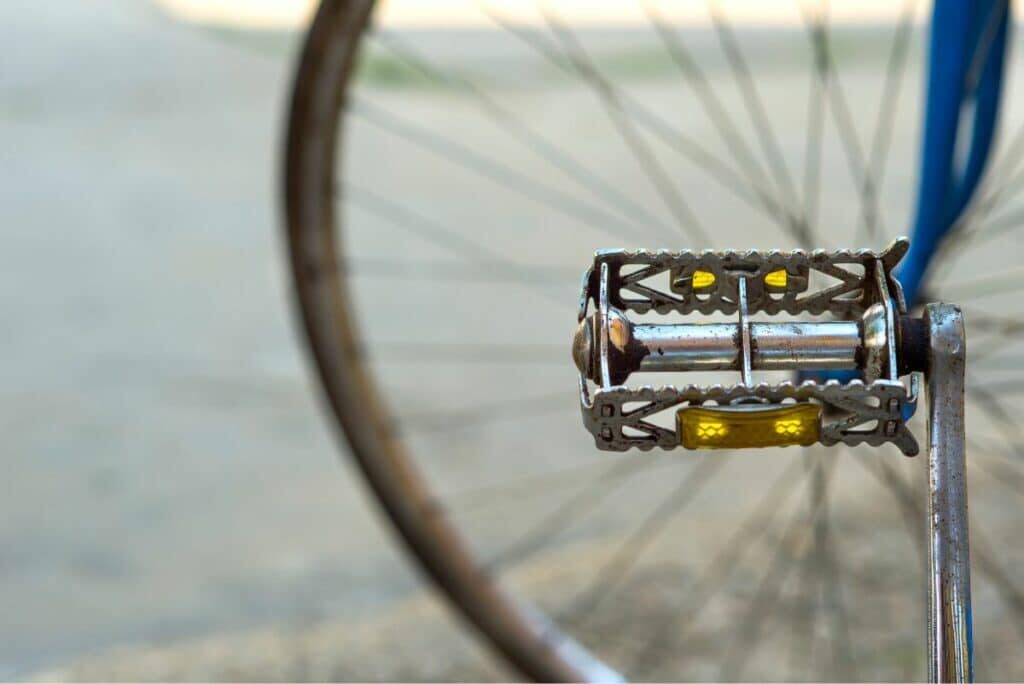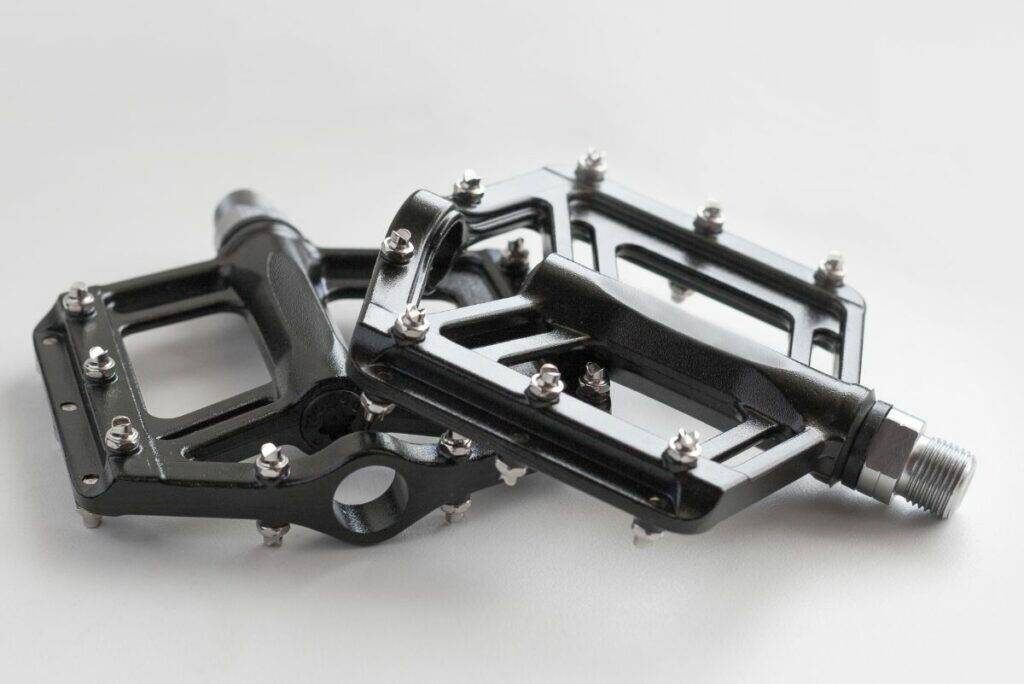Pedals are vital for stable and comfortable cycling. They’re one of the three contact points between rider and bike. Their purpose is to transfer the power created by the rider’s legs.
Commuters and sports cyclists have different requirements from their pedals. Road racers and mountain bikers rely on being able to guarantee a fixed foot position, to stomp down consistent power. They also need quick release mechanisms. Commuters don’t need these features.
How Do Bike Pedals Work?
Bike pedals convert power to move the bicycle. You’d have to run with the bike underneath you if you didn’t have them. They’re fixed to one end of cranks, and work together with a chain and gearing to propel you. You place your feet on them and apply pressure. The crank rotates and the bike moves.
There’s one pedal on each side of the bike for each foot. The pedal is rigidly secured to the crank so that it can’t unscrew when riding. Pedals are designed in different ways but all carry out the same basic function – propulsion.
Bike Pedals for Commuting
Bike pedals for commuting must be comfortable and safe to use. While almost all cranks will accept all types of pedals, you should choose a broad, platform type if you only ride your bike as a commuter. Almost any footwear works with platform pedals, and they work on both sides.
You should consider a clipless pedal if you want to use your bike for exercising or fitness beyond your day to day travel. They’re designed to cater for sportier riding, but most rely on a special shoe which can accept a cleat which clicks onto the surface of the pedal.
Clipless road pedals are designed to work only on one side, while clipless mountain bike pedals do not accept the whole of the balls of your feet. It’s not standard practice to regularly install and remove different pedals from one bike.

Do Bike Pedals Make a Difference?
Bike pedals make a big difference to comfort whilst commuting. Urban riding requires more on and off contact with them. They also offer benefits to sporting and tougher recreational rides. Used incorrectly, pedals will cause knee pain and can lead to embarrassing falls and tumbles.
If we had to choose one key difference between a commuting ride and a sporting ride on the same bicycle, we start to see the benefit of the right pedals. We spend more time off the pedals when we commute. This means we need to have a simple way of getting back on top of them.
Commuting should not be a chase for a Strava segment-busting time, or a race against fellow commuters. Clipless pedals employed by road riders and mountain bikers do help a great deal with controlling the speed we generate and gear selection. They also support some stability at speed. But they’re not the most comfortable to ride unless you have the right footwear.
How to Choose Bike Pedals
Bike pedals should be consistent with the type of riding you do most frequently, on the bike they are selected for. Most sporting bikes with a retail value above £1,500 / $ 1,814 don’t come with pedals supplied, so you’ll have to choose them if you buy a bike at this price range and above.
Commuting bikes tend to have their pedals selected for you. More than likely, these will be the platform-type pedal and made of hardened plastic. Of course you can swap them for others if you like. If your commuter is also used for your weekend pursuits, then clipless pedals may be worth considering.
With the right tools you can swap pedals on any bike. It takes around five minutes and requires no great skill, although some grit is needed in the first couple of turns of the spanner or allen key. However, different pedal sizes do affect your position on the bike and could influence your position on the saddle.
Best Commuter Bike Pedals
For me, the best commuter bike pedals should put comfort and stability above all other considerations. Therefore the platform type pedal would be the best type. If you want to have some additional support for sportier rides and perhaps to test the full range of your bike’s gears, then some form of hybrid system would be a consideration.
Made from hardened plastic and double-sided, platform pedals are robust and tough enough to handle urban riding. They are usually the cheapest option, and are built to be bashed about a bit. You can rest your bike vertically against a kerbstone and minor scrapes will not do as much damage as to a more expensive metal set.

Look Geo City
Look is a brand with a forty year pedigree in pedal manufacture. They were responsible for bringing clipless pedals to the sporting market.
They’re very affordable and relatively light, but the key aspect is their large surface area and compatibility with most office shoes. They have a stud and grip system which will help in wetter weather.
Look’s reputation in the sporting arena will ensure the technical aspects like the bearings will be of sufficient quality to keep you spinning.
DMR V6 Nylon Flat Pedal
These pedals will suit you if you like to engage in a little off-road recreational riding in addition to your commute. They have pins which stand out above the platform. Beware your shins though if you miss your pedal.
They might be best accompanied by a pair of scruffy trainers to get you to and from your place of work or study, as they might not be too compatible with office or dress shoes.
The major challenge with these grippy, light and affordable pedals is sustainability. They cannot be serviced, so once the nylon pins wear down, you might need to get rid of them. That said, they could help to prove your off-road capabilities as you dip your toe (ahem).
Boardman Hybrid Team Pedals
These pedals offer the flexibility of clipping in via a supplied cleat on one side, or riding with a traditional flat shoe on the other. They offer the commuter who likes to get sporty the option of doing both on one bike.
The surface area on the flat side is similar to the standard platform pedal and the metal construction is more robust. The clip-in side of the pedal will easily allow you to switch up to a sportier ride and control without having to replace the pedals.
Sometimes the weighted balance of the clip in side means you have to look down to clip in but after a bit of practice this should become an easy habit. You may even be tempted to roll into work or college in these cool cycling shoes which say they are suited for both clip in and casual use. No more keeping one pair of humid shoes under your desk!
The post Bike Pedals for Commuting [The Ultimate Pedal Guide] appeared first on Discerning Cyclist.
![Bike Pedals for Commuting [The Ultimate Pedal Guide]](http://bicycle.org/wp-content/uploads/2023/01/bike-pedals-metal-1024x684-1-760x508.jpg)